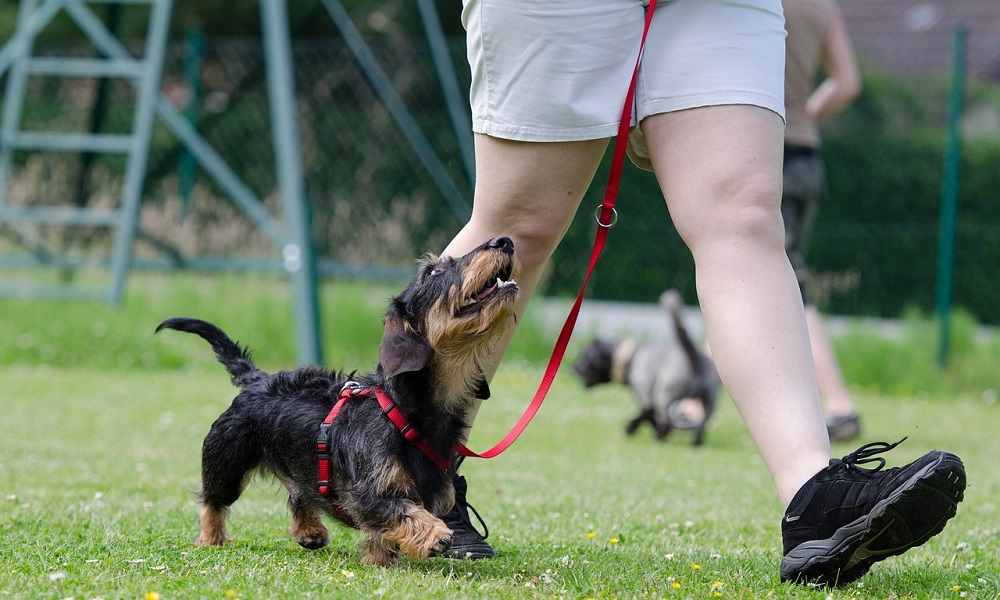How to Use a Dog Training Collar?
Training collars, commonly known as shock collars, are training tools developed for dogs to respond to commands better. These collars help your pet understand.
What you want him to do using some kind of stimulus. This is a minimal electric shock or vibration. The two metal prongs set on the inner side of the collar are responsible for this.
While these collars have some controversy surrounding them, when used correctly, you can be sure that your pet will remain unharmed.
These signals or stimulations are controlled by a remote device that works for a longer distance. Simply pressing the button, again and again, will not tell your pet what to do.
This new stimulus, while easy to feel, has no registration in your canine’s mind. This is where a proper training method comes in.
This includes a series of steps to help your pet learn the meaning behind the electric signals and responding to them by obeying a certain command.
This command can be something as simple as “Sit” and even as complex as boundary training. The trick is to get the message through.
We will teach you exactly how to use the collar, what methods you should employ, and what things you need to avoid. Ready to get your pooch to learn new, healthy habits? Keep reading on.
Why Should You Use a Dog Training Collar?
Dog training has been in practice since people started keeping pets. There are so many methods and ways to teach your pet a new thing.
So why do you need a special collar just for training? The answer is your pet’s uniqueness. All dogs are different, and therefore their training is also never the same.
Some dogs respond to treats and would do their best to overcome any hurdle for these. Other canines learn better in response to praise and love.
When it comes to aggressive or anxious dogs, you cannot simply beckon them to come or sit. What you need is a new method that registers as a proper signal.
This additional attention-grabbing signal is what the training collar provides. Instead of using regular training techniques, here is a list of benefits you can get by the use of an e-collar.
Work Over Longer Distances
One of the cool things about using a training collar is that it works as long as your pet is in the signal range. Unlike regular training.
When your pet is exhibiting aggressive behavior, getting him to come to you by brute force is simply not an option. A slightly higher level of shock signal, however, can definitely reach him.
The trick with e-collars is that they need to be timed precisely, so your pet realizes that as soon as he listens to you, the sensation goes away.
This way, you can train your pet not to bark at strangers and stay in a determined radius even if you are many feet away.
Training Collars can Speed up the Learning Process
Dogs also have their individual preferences. They respond to different stimuli. Conditioning a response has been an old and successful practice and works perfectly with these training collars.
Each time the button is pressed, your pet will feel the vibration somewhere around his neck. If you are able to time this with a verbal command.
Your canine will be able to grasp the connection between the signal and the order. This makes it really quick and easy to get your pet to listen to you.
Helpful in Getting an Aggressive Pet to Listen
Last but not least, using a training collar allows you to communicate with a growling, obviously grumpy or anxious pet. A higher level of shock makes most dogs stop the excessive barking.
Punishment is not the right way to train a dog. If you need to use the higher-level shocks quite often, it is possible that the correct message is not getting through.
Excessive shock levels can confuse and even frighten your dog. If the training is not going well, it is advised to seek professional help before things get out of hand.
How Do You Use a Dog Training Collar – Step by Step Guide
Now that you know the benefits of using a training collar, it is time to get out there and start the training. Before jumping to the first step, you need to know the dog collar and your pet’s aggression level, if any.
Usually, e-collars are not recommended for puppies.
If your pet refuses to meet people and other pets, growls and barks at strangers or has territorial aggression, you will first need to train him to stop that behavior.
It is preferable to keep a positive reinforcement approach as it is more effective and pet-friendly. For most dogs, you can start right away with the regular commands like sit, stay, and come. So, let’s begin:
Step 1: The starter! Training collars are an excellent tool, and it is important that your pet is on good terms with them. Unlike regular collars, these collars have what we call a set of prongs set on the inner side of the main device area.
When putting the collar on, make sure it is loose enough, so the metal prongs don’t keep poking your pet’s skin constantly. These should be in slight contact to deliver the shock without poking.
Once your pet has worn the collar, let him get used to it for some time. Once you feel that your canine is comfortable with it, you can begin the training. It is important that you do not rush your canine.
Step 2: Now that your pet is comfortable wearing the collar, it’s time for him to learn some new skills. Starting off with something really difficult is not recommended.
To help your pet get an idea of the new stimulus, try the collar out with some basic commands. These can also be ones that your pet already knows, as it makes the training easy and fun to begin.
Keep repeating the commands like sit, come and stay till your pet is able to follow each one without any problem.
Only use the training collar if your pet fails to respond even after being called multiple times. Remember, a collar is an aiding tool; it is not crucial for the training but only meant to enhance it.
Once your canine has gone through these, you can move on to some difficult commands.
Step 3: Help your pet learn the meaning of the vibrations and stimuli. In most cases, you will not need to use the collar in the previous step.
Now moving to this step, we need to understand that right now, every time you press the button, the collar only makes your pet feel a little vibration or electric shock.
For your pet to understand what that means precisely, we need to condition a response. The timing needs to be in sync with your voice command.
Step 4: Consider using a leash and call your pet to come towards you. At the same time, press the remote button and give the leash a little tug. When this is coordinated nicely, your pet will look at you and possibly even come to you.
The same trick can also be done if you want to stop bad behavior like barking and growling. The moment your pooch listens to you, release the remote button.
You may need to use a higher level of shock depending on your pet’s reaction. If he listens to you, reward him instantly.
Treats and praise are a perfect combination for a reward and making your pet feel good. Keep repeating until the dog is able to understand without the shock signal.
Step 5: The collar conditioning is very useful and, once mastered, can help you teach your pet more than just coming when called. In this step, you can consider working on your pet’s issue.
If your pooch barks at strangers or tends to run outside the house, try the above method and repeat till necessary. You can also start boundary training.
The trick is to time it nicely and release the button as soon as the canine stops the unwanted behavior or shows the wanted behavior.
In this video how to teach your dog: Use a Dog Training Collar Correctly!
Tips for Using Training Collars
- Always start off with the lowest signal level. Using higher levels can scare and confuse a dog. For the training to be a pleasant, stress-free experience, this is important.
- Rotate the collar after every few hours. This is done to avoid any bad sores on a single part of the neck.
- It is almost never advised to use the highest level of shock, even if the device has a safe range. If you are having trouble getting your pet to listen, it might be time to get some professional help.
- Always show your pet what you want to be done. Pressing the button will not tell your pet what to do; your pet needs to know exactly what the vibration or the shock means.
- Ideally, by the end of the training, your pet should listen to you without the aid of the collar. Therefore, as you progress, slowly decrease the level of the shock and then stop it completely.
- Verbal commands are crucial. Remember to condition your dog with the collar while using your voice at the same time. Even when you are not using the shock collar, you will get the correct response.
- Never use a training collar when your pet is not in sight. When your pet is at such a distance, you may not be able to control the collar as well, which is dangerous for your pet.
Conclusion
Training a pet has never been an easy task, especially if your pet is suffering from behavioral anxiety. Using a training collar can help you reach the canine better and get his attention when required.
E-collars make the training quick and easy. With collar conditioning, you can ensure that your pet is safe and is able to understand what is the desired behavior and what is considered unwanted behavior.
These collars also have a lot of controversies, and when used the wrong way, they can actually harm or traumatize your canine. Recommended to get a good idea of how to use the collar before making your canine wear it.
Start off with the lowest level of vibration and do not increase it unless really necessary. When you follow the right steps, training your pet will be quick, easy and fun both for you and your canine.







